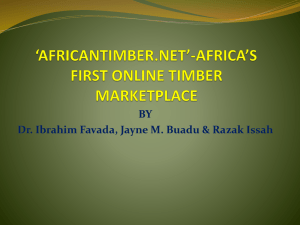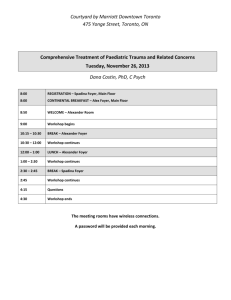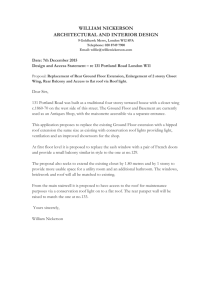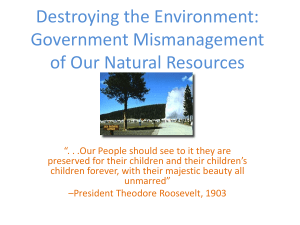20100914 design statement
advertisement
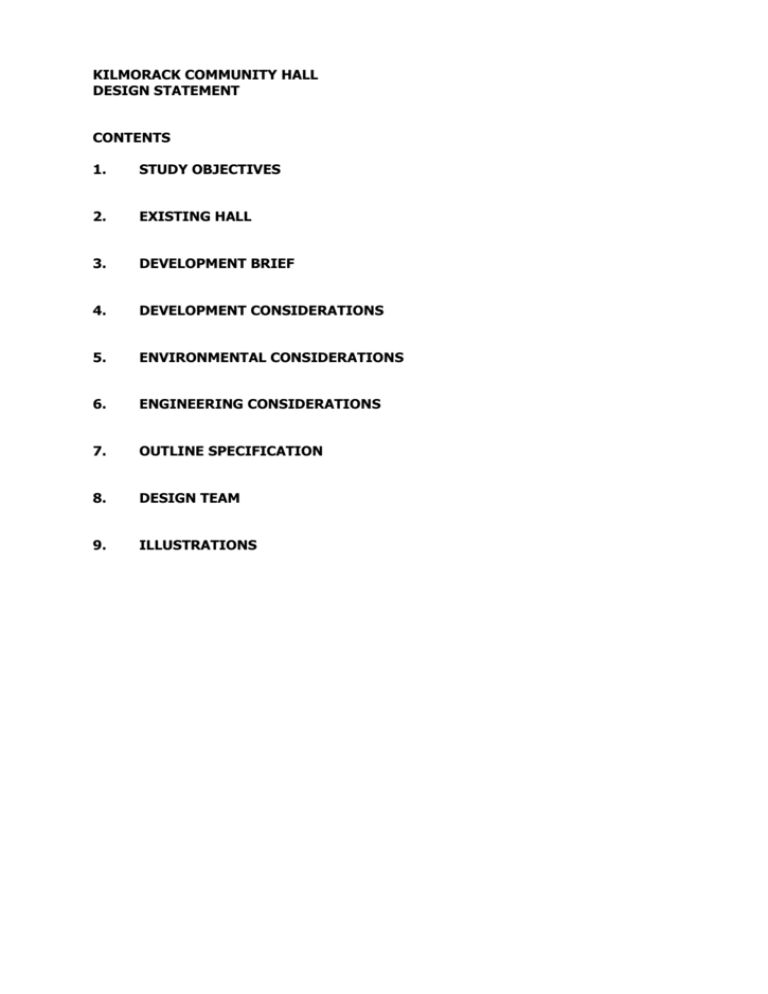
KILMORACK COMMUNITY HALL DESIGN STATEMENT CONTENTS 1. STUDY OBJECTIVES 2. EXISTING HALL 3. DEVELOPMENT BRIEF 4. DEVELOPMENT CONSIDERATIONS 5. ENVIRONMENTAL CONSIDERATIONS 6. ENGINEERING CONSIDERATIONS 7. OUTLINE SPECIFICATION 8. DESIGN TEAM 9. ILLUSTRATIONS 1. STUDY OBJECTIVES INTRODUCTION: This Design Statement has been commissioned by Kilmorack Community Hall Company to investigate improving the existing hall facilities. In preparing the requirements of a study a specialist firm had undertaken extensive community questionnaire and consultation exercise together with CP Architects developing initial design options in December 2008. This exercise concluded that a new build hall was the best option to provide a fit for purpose hall that would sustain the community of Kilmorack into the 21st century. Brief: The briefing requirements were based largely on the results of the community wide survey undertaken by in November 2008., seeking opinion on the facilities and improvements the community would like to see. The general brief was discussed and agreed with the full hall committee at the time of commissioning this Design Study in March 2010. 2. EXISTING HALL: The single storey building was built circa. (1900?) with minor adaptions and extensions for toilets and storage. The site occupies a raised platform above the A831 and Beauly river within a relatively sheltered area surrounded by existing nature species mixed woodland. There is a sloping field to the rear of the hall comprising rough agricultural grazing and native species woodland. An area of this ground is being made available by the landowner for the proposed development. The existing hall is a timber frame building and suspended timber floor with prominent red metal clad walls and pitched roof. A single access tarmac road provides access to hard standing turning and parking area. A mature Scots pine is coated to the rear of the hall on a small hillock but previous storm damage requires this tree to be removed. The existing building construction and condition are substandard in terms of thermal performance and the condition of existing roof, wall and floor finishes are in poor condition. A specialist Rot Survey Report in 2001 identified extensive repairs to flooring due to wet rot causing significant deterioration of the existing floor structure. As a result the ongoing maintenance is likely to be extensive to keep the building serviceable. The layout of the hall and the lack of proper facilities and flexibility together with the difficulty of maintaining suitable internal environment restricts increase usage by the community. Given the current state of repair of the existing hall the time will come when ongoing minor maintenance will no longer be sufficient to keep the building serviceable. The significant investment of a new Community Hall will provide a fresh, new, fit for purpose accommodation with a reduced ongoing maintenance and energy burden to ensure that the community facilities served by the Community Hall can continue into the next generation. 3. DEVELOPMENT BRIEF: This is the outline development brief which has been used in preparation of the Scheme Design. It is a statement of ideas compiled through discussion with the Hall Committee together with users and potential users of the facility. The brief outlines the requirements a new Kilmorack Village Hall based upon demolition of the existing hall and erection of a new build. The Brief The brief seeks to provide accommodation for a wide range of functions from small committee meetings to large public meetings and community events. The key to providing effective accommodation to cover all potential functions is to create a series of rooms and spaces configured as flexible and multi-purpose as possible. The new hall will provide the following accommodation. - New Entrance Area: This will provide improved access facilities for disabled from the car parking area. A covered area also provides direct access to each of the Workshop Units. Vestibule and Foyer: Providing direct access to Main Hall, meeting room, toilets and kitchen with a draught lobby approach to minimise heat loss. - Foyer: The main foyer space can open out into covered area and formed courtyard adjacent to the entrance route. The foyer can act as an exhibition and informal meeting place. - Main Hall: The main space is larger than the existing hall and will be a robust space suitable for indoor sports and community activities with a semi sprung floor. The hall will be open to the roof level with exposed structure but has not been designed for badminton use as this can be provided in Primary School accommodation nearby. The main hall will benefit form natural light with extensive wall glazing, but will incorporate black out blinds. Sliding/folding doors to the foyer allows the Hall to expand into the public areas. - Stage: A fixed raised stage is proposed with storage below, together with backstage areas will incorporate good access to the stage area along with toilet and changing facility and use of meeting room. - Meeting Room: This room will accommodate small groups/meetings and can be split and reused by separate groups to allow independent se. A direct link to the backstage area will allow this to be used to support the stage area as a Green room. - Storage: A number of storage areas have been incorporated in the building particularly the Main Hall with various storage sizes for general storage requirements and specific user groups together with under stage mobile units, accessible from both hall side and back stage areas. - Kitchen: The new kitchen will be suitably sized and equipped to assist in providing catering services for larger gatherings such as wedding receptions and is closely linked to the Main Hall and Foyer with a servery facility. The delivery of goods and removal of rubbish would be by the separate access to the rear. - Toilets: Separate male, female and disabled facilities are provided with baby changing facility. - Services: Electrical: Existing overhead and underground cables require to be diverted as a result of the New Build option. A new supply will be provided to the hall for general power and lighting. Water: Existing mains water services, the existing Hall and a new supply will be connected to the new kitchen. Drainage: An existing septic tank located north east of the hall will be disconnected and made safe and a new treatment plant and soakaway installed for the new hall. BT: There is no existing BT service within the hall but BT lines are in close proximity of the site to allow an underground connection to be provided. - External Works: A new upgraded access is being proposed at the north end of the site to the unclassified public road to improve site lines and provide two way access and turning area in tarmac and new parking including disabled spaces adjacent the entrance area. All parking will be permeable paving. An overspill parking area is proposed to the rear upper level with access provided to the agricultural land adjacent. External paving will provide easy and safe access to the building from car park areas. An external hard surfaced south facing level courtyard area is provided as a flexible break out space, play area and location of temporary marquee facilities. The existing single track access road will be closed off and infilled. The extensive site arisings from the site will be spread out on land to the north and landscaped. Schedule of Accommodation Room Name Entrance Foyer/Lobby Main Hall Meeting Room Kitchen/Servery Toilets (Male/Female/Dis) Plant Storage Main Hall Stage Backstage (changing/wc) Workshops Sub Total Circulation (approx) Overall Net Ground Floor Area Site (m) 4 x 10 16 x 10 8x5 5.7 x 4.3 70.2 x 7.5 1.5 x 3.9 2 x 7.9 4.6 x 8.9 23.5 x 11.5 7.2 x 10.2 Area m² 40.0 165.0 40.0 33.0 40.0 15.5 38.0 38.0 21.0 70.9 469.0 30.0 499.0 4. DEVELOPMENT CONSIDERATIONS: Various options were developed for New Build Schemes for consideration by the Committee in December 2008 which established that any development should ideally be carried out on the land to rear and east of existing hall to allow retention of the hall if possible at the early stages of construction. The optimum plan arrangement created an L-shaped building with the bulk of the hall built into the existing bank and the entrance covered area and workshop wing extending to the west to create a south facing external courtyard area. The new access and parking area would lead directly to this area and clearly articulate the access route to the building. The ground excavation for the building would be utilised to infill the existing road and form the upper parking area and surplus material from the ‘site arisings’ graded on ground to the north. The position of the New Build allows the existing hall to be used for contractors’ welfare and dry storage until removal of it provides for new access turning and parking area. Organisation: The building’s various spaces have been orientated to allow a clearly articulated entrance from the parking area with a shared covered entrance link serving the Main Hall and Workshops. A double height entrance foyer with extensive roof and wall glazing provides a welcoming area with direct access to the Main Hall and other public rooms. Form and Massing: The building form simply expresses the differing volumes and space requirements with higher duo pitched Main Hall with both lean to and duo pitch single storey elements. The metal pitched roof forms replicate the agricultural barn type common to this area and with reference to the existing hall, whilst allowing internal public rooms to take advantage of double height spaces to provide unique and interesting special qualities. The buildings position minimises the impact on the site and integrates into the woodland setting. Materials: The form and materials of the existing hall are well liked by the community and have been used as a inspiration in the new material choice which compliment the rural and agricultural buildings in the area. External walls will be generally self coloured render, coloured red near the entrance area to identify the covered walkway on arrival and white to rear areas facing the hillside. Natural weather finish timber cladding on other areas help reduce the scale of the building appropriate to its rural context and provide a robust, and low maintenance finish. Roof pitches are relatively shallow to compliment farmstead buildings finished in metal profile sheeting colour grey. Velux rooflights and clerestorey windows at high level of the hall will be used throughout to provide natural daylight and reduce requirements for artificial lighting. The building structure will be based upon timber glulam frame and roof truss arrangement and walls in timber frame which will allow advantages of prefabrication, speed of erection and efficient use of natural resources and provide a highly insulated envelope to improve energy efficiency and reduce running costs. All timber shall be specified from renewable sources. Planning Considerations: The Planning Authority have been consulted regarding the proposed scheme and have in principle no objections regarding the demolition of existing hall and erection of new community facility. Guidance and feedback from Forestry Officers have also been taken onboard and removal of existing native species minimised and new planting proposed to retain the mixed woodland environment. 5. ENVIRONMENTAL CONSIDERATIONS: The Hall Committee have established that they desire a building which is energy efficient, utilises Renewable energies which are easy to control and responds to the anticipated usage pattern of the building and has a minimal impact on the environment. As a result the Committee engaged Real Alternatives to carry out an Energy Study to assess the building energy requirements and identify options for different forms of heating including capital and running costs with a low carbon footprint. From this study a preferred option of wood fuel boiler using pellet/woodchip was identified and selected by The Committee as the optimum solution in terms of local natural resource availability, lowest carbon emissions and ability to cope with the fluctuating heating demands on the building. The building design strategy of increasing insulation standards post October 2010 Building Regulation has also been adopted to ensure compliance and reduced energy demand in the future. Schematic Design and Budget Costs were obtained in order to take account of space requirements for boiler plan, pellet storage and servicing. A Heat Recovery Ventilation System is also incorporated into the hall to ensure recycling of heat from toilets and kitchen is utilised in pre-warming fresh air supply to the public rooms and to ensure a fresh and healthy internal environment is maintained. Separate extract cooker hood ventilation is provided to cooking areas to deal with intermittent use of kitchen and cooking smells. Space heating is provided generally by a wet system with thermostatic controls available at each radiator with water pipes circulated at high level to the hall using air fans to disperse warm air to the large volume. 6. ENGINEERING CONSIDERATION: 7. OUTLINE SPECIFICATION: DESCRIPTION OF WORK 1.0 Sub/Superstructure/Foundations: Reinforced concrete pads to Glulam portal frames and columns. Reinforced concrete strip foundations to new external and loadbearing internal walls. Covered area: Douglas fir frame with ss connectors to top and bottom on concrete pad foundations. 2.0 Sub dpc Walls. External: Generally 100mm dense block outer leaf, rendered, 60 cavity, 140mm block inner leaf. Internal.: 140mm/100mm blockwork to loadbearing partitions to Engineers specification 3.0 Floor Types: Ground floor general; 75mm screed, 100mm rigid board insulation, concrete slab, dpm, 50mm sand blinding, type 1 upfill. U-value 0.21W/m²K Sports floor to main hall; as above with Junckers oak flooring on semi sprung battens. Suspended timber to stage with 22mm chipboard finish. 4.0 Wall Types: Type A: Scot larch timber cladding, timber battens(50mm airgap), Breather membrane, Plywood sheathing, 140mm Superglass 032 Mineral wool between nom 150x50 timber studs, vapour barrier, 25mm service void, 12.5mm plasterboard. U-value 0.27W/m²K Type B: Self coloured K-rend or equivalent, block outer leaf, 50mm airgap, Breather membrane, Plywood sheathing, 140mm Mineral wool between timber studs, vapour barrier, 25mm service void, 12.5mm plasterboard. U-value 0.27W/m²K 5.0 Internal Partitions To Engineers specification for loadbearing and non-loadbearing partitions. 6.0 Roofs: Profiled Metal roof sheet(Corus Colorcoat Urban), Breather membrane, 18mm ply sheathing, 200mm Superglass 032 mineral wool insulation(200mm timber rafter depth assumed), Vapour control layer, 12.5mm plasterboard. U-value 0.2W/m²K Galvanised steel rainwater goods by Lindab. 7.0 Ceilings Generally: Plasterboard on s.w. framing- at 2400 above FFL Main Hall: Gyptone acoustic board on s.w. framing following roof slope to main hall. 8.0 Windows: Timber high performance double glazed with low-e-glass, argon gas filled cavity. Manufacturer: Nor Dan Ltd or equiv. ‘Standard’ range. U-value 1.40W/m²K Roof glazing: Double glazing to foyer area:U-value 1.40W/m². Toughened single patent glazing to entrance canopy. 9.0 Doors: External: Timber high performance, double glazed with low-e-glass and argon gas filled cavity. Manufacturer: Nor Dan Ltd or equiv.U-value 1.40W/m²K Internal doors: Generally flush solid core doorsets with wood veneer TBC. Vision panels to corridor/circulation area Concertina type screens to large opening to main hall and roof divider to Multi-purpose room. Ironmongery: Stainless steel Laidlaw Orbis range or equal. 10.0 Woodwork (Internal): Generally: European Redwood for site painting. Skirtings: 19x95mm. OGEE profile. Facings: 19x70mm. OGEE profile. Cills: 25mm. bullnose front edge. Apron: 13x45mm. pencil round. Curtain Rail: 19x70mm, pencil round. Skirting Blocks: 100x55x25mm, bevelled edges. Shelves: 25mm blockboard with hardwood lipping. 11.0 Painterwork: Internal Walls and Ceilings: 1 no base coat and 2 top coats matt emulsion to plasterboard. Internal Timber Surfaces: 1 thinned coat wood stain with 2 coats varnish. Isolated general timber surfaces: 2 coats gloss paint on 1 coat undercoat and primer coat. 12.0 Kitchen/Utility Units: Howdens ‘Calgary’ range or equiv, with stainless steel D-handles and square cornice and pelmet. Continuous solid surface worktops 40mm thick, with 3 no. rows tiles as splashback. 13.0 Sanitaryware: White ware to all whb, wc’s, sinks, cleaner sinks. Proprietary laminate cubicles and vanity units. Stainless steel sinks and drainers to workshops. Doc M package to disabled wc’s. 3 no. rows tiles as splashback. 14.0 Finishes Entrance porch: matwell, coir matting Foyer: Slate tile Kitchen/Toilets: Non slip vinyl Multi-purpose room: Carpet Backstage/stores/rear corridor: Standard vinyl Main Hall: Junckers semi sprung sports floor, oak/beech finish Workshops: Painted concrete. Stage: chipboard finish with sealer paint. 15.0 Services: Existing Services: Existing services runs i.e. power, water and telephone to be examined and lines of distribution noted for future connections Water Supply: New mains supply by arrangement with Scottish Water. Cold water: Mains supply to all fittings – no storage. Hot Water: hot water and heating via Pellet boiler. Main Hall: Junckers semi sprung sports floor, oak/beech finish Electrical Services: New supply and meters.(single or 3 phase) Power Lighting Fire alarm installation Induction loop system External lighting to be automatically switched via photocell or PIR detectors, and to have 20minute delay timer and over-ride switch. Ventilation: Package installation of Mechanical ventilation with heat recovery (MVHR) by specialist supplier/ contractor, comprising the following: - Constant pressure Heat recovery unit mounted in roof void, - Galvanised ducting to all main rooms. - Specific boost to Toilets & Kitchen via PIR grilles fitted with automatic damper. - Specific boost to Main Hall and multi purpose room via CO2/Temp sensor mounted in Main Hall - Extract fans to Main Hall to supplement HR unit - Separate cooker hood to kitchen, ducted to external louvre. Telephones:Allow for installation of duct from main road to pop up within building Drainage:Foul water: By Engineer. Surface water: By Engineer 16.0 Heating: Heating and hot water provided via Wood Pellet Boiler. - 26kw Windhager WIN Exklusiv or equivalent, Distributor manifold & controls for 3x heating circuits, 1xUFH circuit and 1x DHW circuit. - 250ltr cylinder - Sabbiana fan coil units to main hall/Stelrad radiators elsewhere. - All associated circulating pumps, valves, pipework, fillers and interconnecting wiring. - Pellet Hopper/store 17.0 External Works Vehicular surfaces: a) Main access road: Blacktop surfacing. b) Parking bays: permeable paving c) Additional Parking/turning head: Grasscrete 2 cts thermoplastic paint line markings to delineate disabled parking bays at entrance. Pedestrian paving: a) Concrete block paving to courtyard; Marshalls Keyblock or equivalent. b) Concrete Flag Paving surface elsewhere; Marshalls Standard Pimpled surface. Footpaths 1200mm wide generally. Any ramping at exits shall not exceed 1:12/max 2m going; 1:15/max 5m going; 1:20/max 10m going, with landings min 1500mm long top and bottom. 300mm gravel strip against external wall generally. Fencing to site boundaries, 1200mm high timber rylock. Landscaped with replacement tree planting. Grass seeding on 150mm topsoil to re-graded areas. External lighting to covered area, exits, bollards, perimeter of building and car park. Random rubble stone walls, 900mm to courtyard. Gabion baskets retention to rear slopes to engineers specification. 8. DESIGN TEAM: All of the Design Team embers have been involved in providing information for this study. All members have extensive experience of working with community groups and village hall buildings throughout the highlands. The Design Team would be made up as follows: - Architect /CDM-Coordinator: CP Architects 110 George Street Oban Argyll PA34 5NT Tel: 01631 563177 Email: mail@cparchitects.net - Quantity Surveyor: Armour & Partners 17 Queensgate Inverness IV1 1DF Tel: 01463 232365 Email: david.mitchell@armour-qs.co.uk - Civil/Structural Engineer: KWA Consulting Engineers Ltd Inchrory Drive Dingwall Business Park Dingwall IV15 9XU Tel: 01349 863333 Email: info@kwa.uk.net - Energy Consultant: Real Alternatives Ltd Barrahormaid Farm House Tayvallich Lochgilphead Argyll PA31 8PQ Tel: 01546 870266 Email: info@real-alternatives.co.uk 9. ILLUSTRATIONS: - Existing Photographs - Location Plans - Block Plans - Site Plan - General Arrangement Plans - General Arrangement Sections and Elevations - 3D Views




